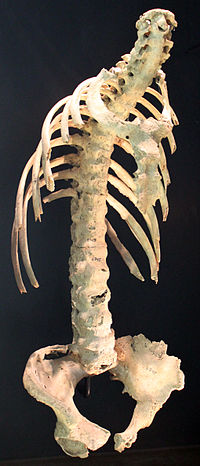
Photo from wikipedia
Background Criteria for inflammatory back pain (IBP) in spondyloarthritis (SpA) include the Calin, Berlin, and Assessments in SpA International Society (ASAS) criteria, although no studies have undertaken comparative validation to… Click to show full abstract
Background Criteria for inflammatory back pain (IBP) in spondyloarthritis (SpA) include the Calin, Berlin, and Assessments in SpA International Society (ASAS) criteria, although no studies have undertaken comparative validation to determine which are optimal versus the rheumatologist expert opinion gold standard assessment. Objectives We aimed to compare IBP criteria in unselected patients presenting with undiagnosed back pain to rheumatology practice. Methods The Screening for Axial Spondyloarthritis in Psoriasis, Iritis, and Colitis (SASPIC) Study is aimed at the development and validation of a triage strategy for detection of axial SpA in patients presenting with undiagnosed back pain. Consecutive patients ≤45 years of age with ≥3 months undiagnosed back pain with any one of psoriasis, acute anterior uveitis, or colitis diagnosed by the relevant specialist undergo routine clinical evaluation by a rheumatologist for axial SpA. The rheumatologist determines the presence or absence of IBP (defined as <5 or >5 on 0–10 scale, respectively) and axial SpA (yes/no) after the clinical evaluation and review of labs (B27, CRP) and imaging (x-ray, MRI). Clinical and laboratory data, radiographs and MRI scans are also assessed centrally for diagnosis of axial SpA (yes/no). We assessed sensitivity and specificity of each of the IBP criteria for diagnosis of IBP according to the local rheumatologist, diagnosis of axial SpA by local rheumatologist, diagnosis of axial SpA by central assessment, and concordant diagnosis of axial SpA by both local and central assessment. Results We recruited 185 patients (48.6% male, mean age 27.6 years, mean back pain duration 7.0 years) with iritis (30.3%), psoriasis (17.3%), Crohn's (38.4%) and ulcerative colitis (18.9%). IBP and/or axial SpA were considered present in 65.2% and 47.3%, respectively, of all patients by the local rheumatologist. By central assessment axial SpA was considered present in 32.7% while amongst patients with a concordant diagnosis by both local and central assessment 37.2% were considered to have axial SpA. Sensitivity was comparatively high for all IBP criteria but specificity was poor. The Berlin criteria consistently performed best while the Calin criteria consistently performed worst (Table). Gold standard IBP criteria Sensitivity Specificity LR+ LR− (%) (%) IBP by local rheumatologist ASAS 83.8 58.8 2.03 0.28 Berlin 88.9 76.5 3.78 0.15 Calin 94.0 37.3 1.50 0.16 Axial SpA by local rheumatologist ASAS 82.9 44.9 1.50 0.38 Berlin 84.3 51.3 1.73 0.31 Calin 90.0 19.2 1.11 0.52 Axial SpA by central assessment ASAS 80.0 37.5 1.28 0.53 Berlin 80.0 38.9 1.31 0.51 Calin 94.3 20.8 1.19 0.27 Axial SpA by central and local assessment ASAS 86.2 44.9 1.56 0.31 Berlin 86.2 51.0 1.76 0.27 Calin 93.1 22.4 1.20 0.31 Conclusions IBP criteria lack specificity for rheumatologist diagnosed IBP or axial SpA but the Berlin criteria have consistently better performance. Disclosure of Interest None declared
Journal Title: Annals of the Rheumatic Diseases
Year Published: 2017
Link to full text (if available)
Share on Social Media: Sign Up to like & get
recommendations!